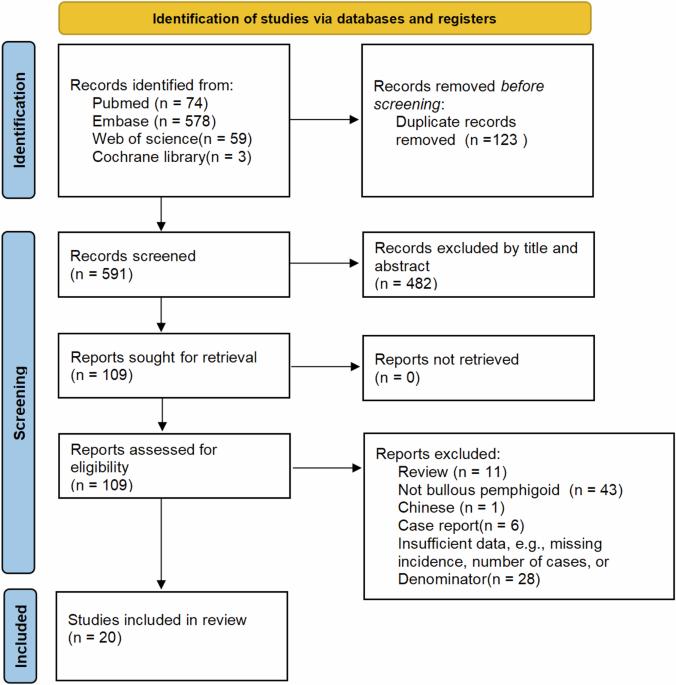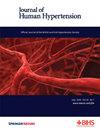Association between bullous pemphigoid and hypertension: a systematic review and meta-analysis of observational studies
IF 3.4
4区 医学
Q2 PERIPHERAL VASCULAR DISEASE
引用次数: 0
Abstract
Studies have indicated a relationship between bullous pemphigoid (BP) and hypertension, but the findings remain controversial. To examine this association, we conducted a systematic review using studies from PubMed, EMBASE, Web of Science, and the Cochrane Library, applying a random-effects model while performing subgroup and sensitivity analyses to explore potential sources of heterogeneity. Subgroup analyses were performed by country, data source, and sample size. The quality of evidence was evaluated using the Newcastle-Ottawa Scale. The review protocol was registered in PROSPERO (ID: CRD42024573911). The analysis included 20 studies, primarily consisting of case-control studies from Europe and Asia, encompassing 72,981,822 participants, of whom 29,199 had BP. The mean ages of the BP group and the non-BP group were 74.62 and 74.25 years, respectively. Random-effects meta-analysis demonstrated a significant association between BP and hypertension (odds ratio [OR] = 1.13, 95% confidence interval [CI]: 1.07–1.20). Subgroup analyses revealed stronger associations in database studies (OR = 1.24, 95% CI: 1.17–1.31) and in studies with over 1000 BP cases (OR = 1.30, 95% CI: 1.23–1.37). No significant association was observed in studies conducted in Asia (OR = 1.05) or Europe (OR = 1.07). However, a significant relationship was found in studies from the United States (OR = 1.29, 95% CI: 1.12–1.48). This study found a significant correlation between BP and hypertension, particularly in the United States. However, as most included studies were observational in nature, causality cannot be inferred. Further research is needed to elucidate the underlying mechanisms and causal relationship between BP and hypertension.

大疱性类天疱疮与高血压之间的关系:观察性研究的系统回顾和荟萃分析。
研究表明大疱性类天疱疮(BP)与高血压之间存在关系,但研究结果仍存在争议。为了检验这种关联,我们对PubMed、EMBASE、Web of Science和Cochrane图书馆的研究进行了系统回顾,应用随机效应模型,同时进行亚组分析和敏感性分析,以探索潜在的异质性来源。按国家、数据来源和样本量进行亚组分析。使用纽卡斯尔-渥太华量表评估证据质量。该审查方案已在PROSPERO注册(ID: CRD42024573911)。该分析包括20项研究,主要由来自欧洲和亚洲的病例对照研究组成,包括72,981,822名参与者,其中29,199名患有BP。BP组和非BP组的平均年龄分别为74.62岁和74.25岁。随机效应荟萃分析显示,血压与高血压之间存在显著相关性(优势比[OR] = 1.13, 95%可信区间[CI]: 1.07-1.20)。亚组分析显示,在数据库研究(OR = 1.24, 95% CI: 1.17-1.31)和超过1000例BP病例的研究(OR = 1.30, 95% CI: 1.23-1.37)中,相关性更强。在亚洲(OR = 1.05)或欧洲(OR = 1.07)进行的研究未观察到显著相关性。然而,在美国的研究中发现了显著的相关性(OR = 1.29, 95% CI: 1.12-1.48)。这项研究发现血压和高血压之间存在显著的相关性,尤其是在美国。然而,由于大多数纳入的研究本质上是观察性的,因此无法推断因果关系。血压与高血压的发病机制及因果关系有待进一步研究。
本文章由计算机程序翻译,如有差异,请以英文原文为准。
求助全文
约1分钟内获得全文
求助全文
来源期刊

Journal of Human Hypertension
医学-外周血管病
CiteScore
5.20
自引率
3.70%
发文量
126
审稿时长
6-12 weeks
期刊介绍:
Journal of Human Hypertension is published monthly and is of interest to health care professionals who deal with hypertension (specialists, internists, primary care physicians) and public health workers. We believe that our patients benefit from robust scientific data that are based on well conducted clinical trials. We also believe that basic sciences are the foundations on which we build our knowledge of clinical conditions and their management. Towards this end, although we are primarily a clinical based journal, we also welcome suitable basic sciences studies that promote our understanding of human hypertension.
The journal aims to perform the dual role of increasing knowledge in the field of high blood pressure as well as improving the standard of care of patients. The editors will consider for publication all suitable papers dealing directly or indirectly with clinical aspects of hypertension, including but not limited to epidemiology, pathophysiology, therapeutics and basic sciences involving human subjects or tissues. We also consider papers from all specialties such as ophthalmology, cardiology, nephrology, obstetrics and stroke medicine that deal with the various aspects of hypertension and its complications.
 求助内容:
求助内容: 应助结果提醒方式:
应助结果提醒方式:


